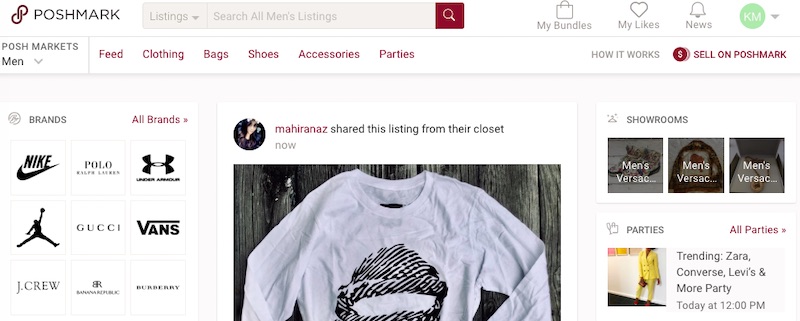
Recommerce, the process of selling used products or excess inventory, is growing 20-times faster than the broader retail market. An example is thredUp, which receives used merchandise from consumers and then resells it.
Recommerce — “resale commerce” — is the process of selling used products or excess inventory to companies or consumers. Both Millennials (birth years early 1980s to late 90s) and Generation Z (late 90s to roughly 2012) are embracing the concept of purchasing secondhand goods. They are more than two times likely to engage with recommerce than older consumers, according to GlobalData, an independent retail analytics firm that performed research for the “2019 Annual Resale Report” for recommerce apparel merchant thredUP.
While consumers have been buying used books, CDs, and DVDs for years, people under 40 are enthusiastically scooping up clothing, jewelry, shoes, and handbags. Gen Z is showing the highest growth rate for “thrifting.”
Fifty-six million women of all ages purchased secondhand products in 2018. While most buyers use the secondhand items themselves, others purchase goods for resale on sites such as eBay.
Recommerce merchants are growing 20-times faster than the broader retail market and five-times faster than off-price retailers, according to Coresight Research. The company forecasts that the total U.S. apparel resale market will grow at a compound annual rate of 13 percent, reaching $33 billion in 2021. Clothing, shoes, and accessories currently make up 49 percent of the total U.S. recommerce market. GlobalData estimates that the total worldwide apparel market (resale and donation) will climb to $51 billion in 2023.
Leading recommerce companies include thredUP, TheRealReal, and Poshmark.
thredUP
thredUP accepts only certain brands but does not focus exclusively on luxury merchandise, although the site includes a high-end “Luxe” division that sells designer brands from invited sellers.
Individuals who wish to empty their closets can request a postage-paid clean-out kit to send clothes, shoes, handbags, and jewelry for consideration. thredUP is selective and accepts only 40 percent of items sent. All Luxe items are authenticated by in-house experts to ensure they are not counterfeit. Goods that are not accepted or that do not sell are recycled. Sellers can also ask for their clothing to be returned, but they must pay a fee to do so.
The company uses an algorithm that looks at the brand, style, season, and current inventory to price items. The company also offers donation bags for those who want to dispose of items.
Earlier this month, thredUP announced partnerships with J.C. Penney, Macy’s, and Stage stores. Pilot projects for the three retailers are in about 100 stores with a larger rollout planned.
The retailers pay to build thredUP spaces in-store, and they are stocked with thredUP’s inventory. Customers can also drop off their used clothes, which are sent to thredUP warehouses. Partner retailers intend to draw more shoppers into the stores, hoping some of them will purchase the store’s regular inventory.
TheRealReal

TheRealReal
TheRealReal is an eight-year-old consignment company, which focuses on luxury brands (clothing, jewelry, art, home decor), also provides sellers with a pre-paid shipping package to send goods. Like thredUP, TheRealReal authenticates items to ensure they are not counterfeit. Products that haven’t sold after a year can be sent back to sellers, at their cost. Otherwise, unsold inventory is donated to charity.
Sellers are paid on a sliding scale. When an item sells, the seller receives a percentage of the sale price (50 percent for items priced at $200 or less, and up to 70 percent for products that sell for at least $10,000.)
Kering, the Paris-based parent company of Gucci, Balenciaga, Saint Laurent, and other luxury brands, partners with TheRealReal, placing unsold inventory on the site. A partnership with fashion brand Stella McCartney lets sellers that consign pieces from this brand receive a $100 Stella McCartney gift card.
TheRealReal also has brick-and-mortar stores in Los Angeles and New York.
In 2018, TheRealReal processed 1.6 million orders for its second-hand items, 42 percent more than in 2017, according to the company. The site’s gross merchandise value in 2018 was $710.8 million, up 44 percent over 2017, with total revenue of $207.4 million, up 55 percent. Nevertheless, the company is not yet profitable, with a net loss in 2018 of $75.8 million. In June, TheRealReal went public and raised $300 million, at $20 per share.
Poshmark

Poshmark
Poshmark is a marketplace for used goods. It does not use the consignment model. Sellers must manage their own listings, including photos, descriptions, and pricing. Sellers ship the sold goods to buyers using a prepaid shipping label provided by Poshmark. In exchange, sellers keep more of the sales proceeds than they would through a traditional consignment shop. For items with a sale price lower than $15, Poshmark charges a flat fee of $2.95. More expensive items are subject to a 20-percent commission.
Poshmark offers Posh Parties, which are virtual buying and selling events within the application. Individuals can browse, buy, and list together with friends.
Other Sites
Yerdle offers a white label service for apparel retailers Arc’teryx, Eileen Fisher, Patagonia (Worn Wear label), REI, and Taylor Stitch, letting customers return used goods for store credit. When Yerdle receives the goods, it repairs and refurbishes them so that the apparel companies can resell them as refurbished under their own brands with warranties.
Paris-based Vestiaire Collective allows consumers to list used luxury products themselves or use Vestiarie’s consignment service. Most sellers are based in Europe.
Environmental Impact
The equivalent of one garbage truck of textiles is sent to a landfill or incinerated every second, according to The Ellen MacArthur Foundation, a U.K.-based charity that promotes the circular economy. Consumers, especially younger ones, want the brands they buy to be conscious of the environmental impact of their practices. thredUP, for example, estimates that it has upcycled 65 million articles in the past five years — 21 million in 2018 alone — saving these items from landfills.
In 2018 British luxury fashion brand Burberry received scathing criticism for burning about $38 million worth of new, unsold clothing, accessories, and perfume so that none of it could reach the gray market. The company has responded to the criticism by declaring it will no longer destroy the goods.
Burberry is not unique; many brands destroy “deadstock” in the same way. Partnerships with recommerce merchants allow brands to showcase their sensitivity to the environment and increase customer loyalty.





